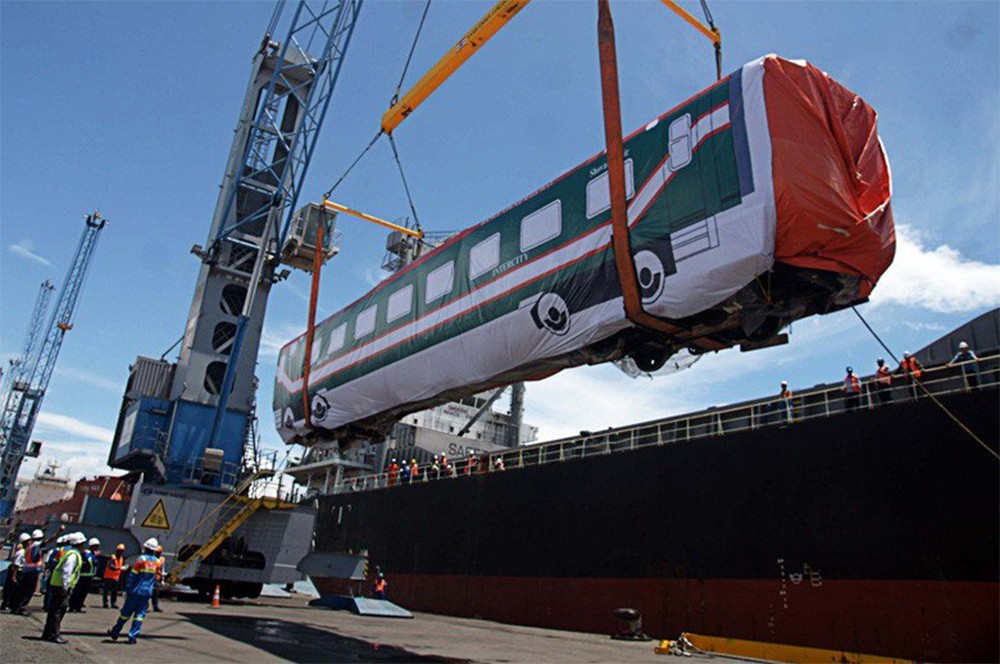Popular Reads
Top Results
Can't find what you're looking for?
View all search resultsPopular Reads
Top Results
Can't find what you're looking for?
View all search resultsIndonesia sees gloomy outlook with poor export performance
Change text size
Gift Premium Articles
to Anyone
 Breakthrough – A railway car manufactured by state-owned train manufacturer PT Industri Kereta Api (INKA) is loaded onto a cargo vessel, which will bring it to Bangladesh. INKA has begun its first passenger train exports by shipping 15 passenger trains to Bangladesh, the first batch of the total shipment of 150 passenger trains ordered by Bangladesh Railways. (thejakartapost.com/Wahyoe Boediwardhana)
Breakthrough – A railway car manufactured by state-owned train manufacturer PT Industri Kereta Api (INKA) is loaded onto a cargo vessel, which will bring it to Bangladesh. INKA has begun its first passenger train exports by shipping 15 passenger trains to Bangladesh, the first batch of the total shipment of 150 passenger trains ordered by Bangladesh Railways. (thejakartapost.com/Wahyoe Boediwardhana)
I
ndonesia is likely to find it a challenge matching, let alone surpassing, its trade performance last year as the value of exports nosedived by double-digits during the first eight months of 2016.
On Thursday, the Central Statistics Agency (BPS) reported that the country’s exports stood at US$91.73 billion in the January-August period, down by 10.61 percent compared to the corresponding period last year.
In 2015, the value of Indonesia’s total exports reached $150 billion while imports stood at $142 billion.
BPS deputy head for distribution and statistics Sasmito Hadi Wibowo said Indonesia must ship goods worth an average of $15 billion overseas every month until the end of the year to achieve a similar export figure to last year. “Given the current weak conditions, it will be difficult [to reach the target]. As of now, we have only seen $12 billion of exports per month on average,” he said.
Institute for Development of Economics and Finance (Indef) trade researcher Muhammad Hanif also believes it will be hard for Indonesian exports to reach beyond $150 billion, citing time constraints and weak global demand.
“It’s very tough to do,” he said.
The global economic slowdown has led to the collapse of South Korea’s biggest container line Hanjin Shipping Co., which transported an estimated 5 percent of Indonesia’s exports and imports, including consumer goods, chemicals and industrial components.
Hanjin, the world’s seventh-largest shipping line, filed on Aug. 31 for bankruptcy protection in the US to protect its assets from being seized by creditors. The company, which operates more than 60 vessels, reported that it had debts of $5.5 billion as of June, against a backdrop of sluggish international trade.
In a research note distributed on Thursday, Bank Central Asia (BCA), the country’s largest private lender by assets, however, suggested that export activities are likely to improve by year-end, as macro stabilization in the G3 (US, eurozone and Japan) and also in China, boosts demand.
However, there might be downside risks from an anticipated move by the US Federal Reserve to increase interest rates and a lack of improvement in the crude palm oil (CPO) market outlook, all of which could suppress commodity prices.
Both Hanif and Sasmito acknowledged that the Hanjin collapse would have an impact on supply chain flow, causing delivery and production delays, as much of the products shipped include raw components for manufacturers.
However, the line’s problems should not affect Indonesia’s trade balance significantly as other shipping firms are waiting to step in.
To boost monthly export growth, the BPS recommends an increase in the export of processed goods.
The export proportion of processed goods rose to 76.68 percent in the January-to-August period, compared to 71.67 percent in the corresponding period last year.
The processed products include palm oil with an export value of $9.2 billion; clothing, $4.2 billion; jewelry, $3.5 billion; cars and spare parts, $3.2 billion; electric devices, $2.9 billion; gold, $1.4 billion; and processed coffee beans at $359 million.
“Global demand has not recovered yet but we can create demand by offering processed goods at competitive prices and we can do that because we have a great deal of raw materials,” the BPS’ Sasmito said.
He gave as examples Indonesia’s abundant production of rubber, CPO, coffee and chocolate, all of which can be processed.
Although a decline in total exports is expected this year, exports increased significantly by 32.54 percent to $12.63 billion in August, up from $9.53 billion in July thanks to a rebound from the previous month, during which fell the two-week Idul Fitri holiday season.
However, imports rose by 36.84 percent month-on-month (mom) to $12.34 billion last month. The import of various products ranging from mechanics and electronic devices, steels, cars, wheat, beef, sugar, corn and plastics from China, Thailand, Australia, Brazil, South Korea, Vietnam, Germany and Taiwan dragging down the trade balance.









